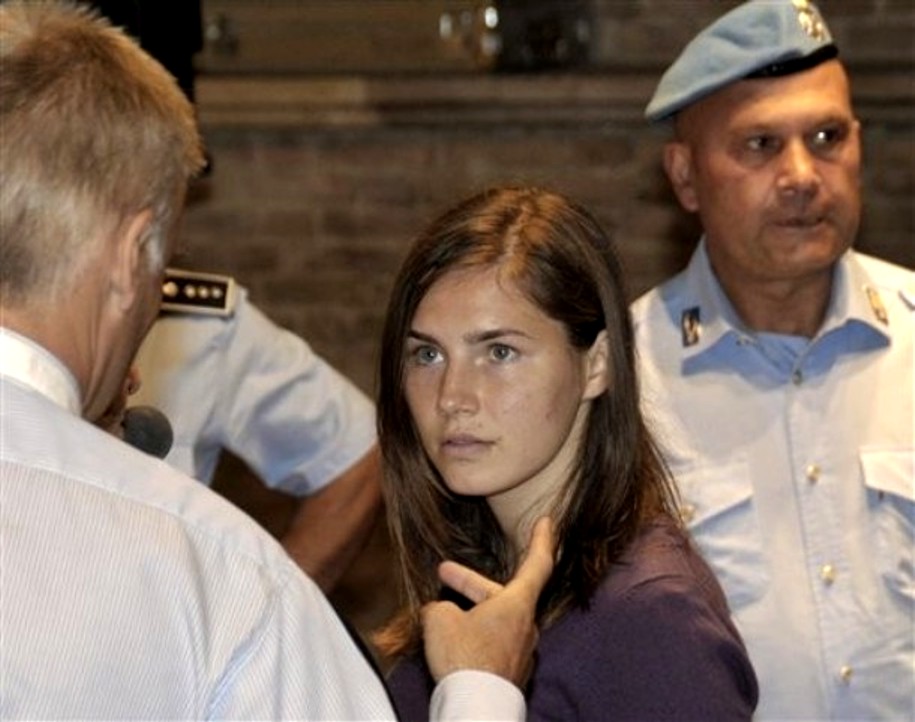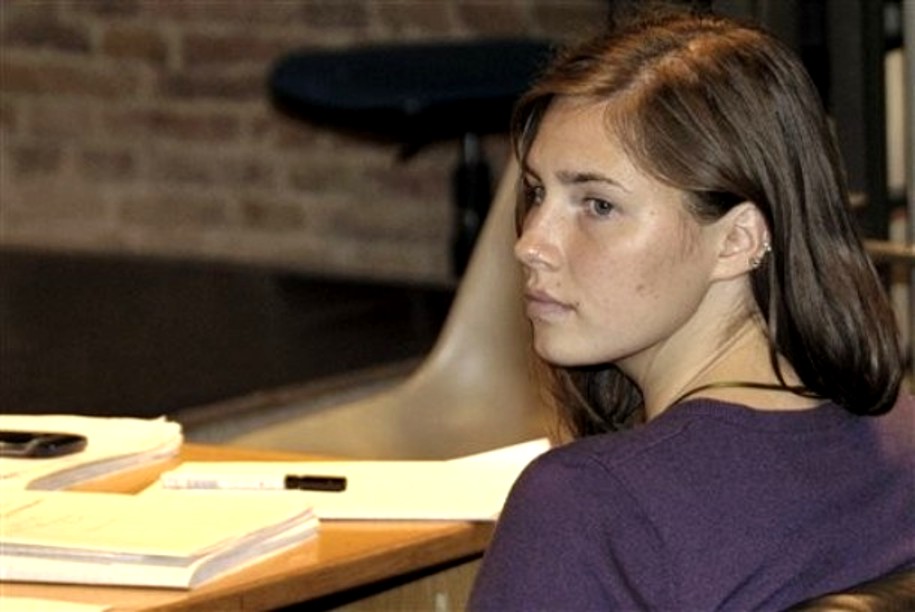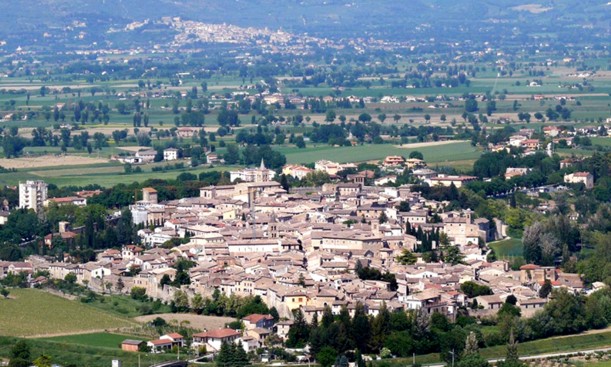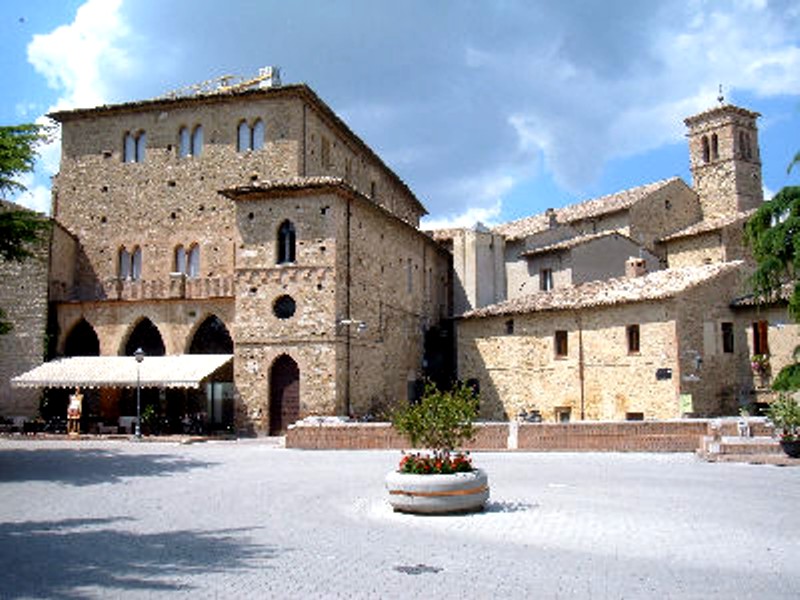
Thursday, July 23, 2009
Case For The Prosecution: #2 The Tough Footprint Evidence
Posted by The Machine
1. Preamble
This series is a summary of the prosecution’s case in five parts, with a commentary on matters of key significance.
The material has been reordered so that evidence presented at several points in the trial can be described in one post here. Sources used are the many published reports and some transcripts made of the testimony. The first post, below, was on the formidable DNA evidence.
In this post we now elaborate the footprint evidence, some of which is easily visible and some of which is only apparent with the use of luminol.
We reported what happened in the court here and here.
Kermit in his Powerpoint series provided us with accurate prior analysis and post analysis of these flootprints and shoeprints, and Kermit also presented a Powerpoint map of the cottage.
2. About luminol
Luminol is a chemical that reacts with the microscopic particles of iron in the blood if a partial but incomplete attempt has been made to clean a bloodstain away.
The blood traces glow a bright blue quite fleetingly in the dark under luminol, just long enough to allow forensic investigators to measure and photograph it.
Luminol evidence can be among the most compelling. If bloodstains show up under luminol, but not to the naked eye, then it is almost a complete certainty that a crime-scene clean-up has been attempted.
Lorenzo Rinaldi is the director of the print-identity division of Italy’s scientific police, the Italian equivalent of Scotland Yard or the FBI. He testified that one visible and three luminol-revealed footprints and a visible shoeprint belonged to the present two defendants, Amanda Knox and Raffaele Sollecito. (Another shoeprint belonged to Guede, convicted last October.)
3. Evidence Against Amanda Knox
Amanda Knox’s footprints were found set in Meredith’s blood in two places in the hallway of the new wing of Meredith’s house. . One print was exiting her own room, and one print was outside Meredith’s room, facing into the room. These bloody footprints were only revealed under luminol.
The fact that there was an absence of any visible bloody footprints from Meredith’s room where Meredith’s blood was to the visible bloody footprint on the blue bathmat in the bathroom that Meredith and Knox shared strongly indicates that some prints were successfully cleaned away altogether.
A woman’s bloody shoeprint which matched Amanda Knox’s foot size was found on a pillow under Meredith’s body. Barbie Nadeau noted the significance of this evidence on The Daily Beast website:
“When the judge asked Rinaldi the size of an unidentified bloody shoeprint found on the pillow below Kercher’s body, he responded, “Between 36 and 38.” The judge then asked Rinaldi what size shoe Knox wears. “The Skecher shoe we sequestered belonging to Amanda Knox corresponds with size 37.”
The significance of the woman’s bloody shoeprint in Meredith’s room is considerable. By itself it debunks the myth that some had propagated for a while, that Rudy Guede acted alone. The bloody shoeprint was incompatible with Meredith’s shoe size.
4. Raffaele Sollecito
Two bloody footprints were attributed to Raffaele Sollecito. One of them was revealed by luminol in the hallway, and the other one was easily visible to the naked eye on the blue bathmat in Meredith’s and Knox’s shared bathroom.
Lorenzo Rinaldi excluded the possibility that the bloody footprint on the blue bathmat was the right size or shape to belong to Knox or Guede instead of Sollecito: “You can see clearly that this bloody footprint on the rug does not belong to Mr. Guede, but you can see that it is compatible with Sollecito.”
Andrea Vogt’s report for the Seattle Post-Intelligencer shows just how meticulous and painstakingly detailed the analysis of the bloody footprints was:
“All the elements are compatible with Mr. Sollecito’s foot,” Rinaldi said, pointing with a red laser to a millimeter-by-millimeter analysis of Sollecito’s footprint projected onto a big-screen in the courtroom. He used similar methods to exclude that the footprint on the bath mat could possibly be Guede’s or Knox’s.
“Those bare footprints cannot be mine,” said Sollecito in a spontaneous statement…. But the next witness, another print expert, again confirmed Rinaldi’s testimony, that the print, which only shows the top half of the foot, matches the precise characteristics of Sollecito’s foot….
Rinaldi’s detailed PPT described methods of image analysis, metric and grid measurement of the ball, toe, heel and arch, as well the particular characteristics of the footprints and shoeprints as well as the actual shoes and feet of Knox, Sollecito and Guede. The three suspects gave their footprints and fingerprints at police headquarters.”
Another print expert also testified that the bloody footprint on the blue bathmat matched the precise characteristics of Sollecito’s foot.
Amanda Knox’s lawyer, Luciano Ghirga, asked Dr. Stefanoni to confirm that other substances like bleach or fruit juice can also react to luminol.
Dr. Stefanoni acknowledged that they do, but pointed out that biologists who work regularly on crime scenes distinguish easily between the bright blue glow of a blood trace and the much fainter glow from other reactive substances
Tuesday, July 21, 2009
Case For The Prosecution: #1 The DNA Evidence
Posted by The Machine

[Above: Prosecutor Manuela Comodi, click for larger image]
1. Preamble
Nearly 200 hours over 23 days.
That is how long the prosecution took to present its voluminous case against Amanda Knox and Raffaele Sollecito, including time taken by the defense teams to conduct cross-examinations.
This series is a summary of the prosecution’s case in five parts, with a commentary on matters of key significance. The material has been reordered so that for example the DNA evidence presented at several points in the trial can all be described in one post here.
Sources used are the many published reports and some transcripts made of the testimony. All the main witnesses will be named in this series with a brief mention of who they are and their qualifications.
Two past posts that may aid in understanding the DNA testimony are Nicki’s post here and Fiori’s post here. All past DNA posts can be found in this area.
2. The Large Double DNA Kitchen Knife
The double DNA knife is the knife that was sequestered from Sollecito’s apartment. Although there was an imprint of another knife at the scene, and one defense expert argued that there may have been yet another, it remains plausible that this is the weapon that was used to murder Meredith.
Dr. Patrizia Stefanoni was the leader of the forensic team from Rome that carried out all the forensic collections at Meredith’s house. She testified unequivocally about the knife. A small sample of Meredith’s DNA was found to be in a groove on the blade, and Amanda Knox’s DNA was found to be on the handle.
Dr. Stefanoni noted that there were peculiar diagonal scrapes on the knife blade, which suggested that the knife had been vigorously cleaned.
Both Dr. Renato Biondo, the head of the DNA Unit of the scientific police, and the Kerchers’ own DNA expert, Professor Francesca Torricelli, provided independent confirmation that this forensic finding is accurate and reliable.
The defence teams’ forensic experts are not disputing that Meredith’s DNA was on the blade of the knife. Instead they are arguing that the knife was somehow contaminated for the DNA to actually be there.
Dr Stefanoni has firmly excluded this possibility of contamination in transit or in the laboratory. She testified that there hasn’t been a single instance of contamination in her laboratory for at least the last seven years, and every precaution was taken here to ensure that different traces were not mixed.
A police officer who led a search of Sollecito’s apartment added weight to the prosecution’s assertion that the double DNA knife had been cleaned with bleach. He testified that he had been struck by “the powerful smell of bleach”.
When Raffaele Sollecito heard that the scientific police had found Meredith’s DNA on the double DNA knife in his apartment, he did not deny the possibility of the DNA being there.
Instead he made a claim about accidentally pricking Meredith’s hand whilst cooking at his apartment. “The fact that Meredith’s DNA is on my kitchen knife is because once, when we were all cooking together, I accidentally pricked her hand.’‘
However Meredith had never been to Sollecito’s apartment and so it seems Sollecito could not have accidentally pricked her hand there whilst he was cooking. In attempting to explain the presence of Meredith’s DNA on the blade, he did so in a way easily disproved and seemed to further implicate Amanda Knox and himself.
3. Sollecito’s DNA On Meredith’s Bra Clasp
An abundant amount of Raffaele Sollecito’s DNA was found on Meredith’s bra clasp, and Dr. Stefanoni has excluded the possibility of any contamination.
This is the bra clasp that was collected some weeks after the first forensic collection and it was conceded that it should have been collected earlier. It was also argued that valid DNA evidence in other cases is often collected weeks or months or even years after the crime when a suspect object is unearthed.
Sollecito’s lawyer Ms Buongiorno is perhaps not surprisingly claiming that this bra clasp was also contaminated in the laboratory. The problem for them is to explain precisely where such an abundant amount of Sollecito’s DNA could have come from, and how it was so firmly imprinted.
The only other instance of Sollecito’s DNA at the cottage was found on a cigarette butt in the kitchen, seemingly an unlikely source at best.
It would seem unlikely that the judges and jury will conclude that the bra clasp was contaminated in a strictly controlled laboratory where Dr. Stefanoni follows rigorous laboratory procedures. She is an internationally renowned and very experienced forensic expert and was part of a Disaster Investigations Team which identified disaster victims via their DNA.
Alberto Intini is the head of the Italian police forensic science unit. Andrea Vogt reported as follows in the Seattle Post-Intelligencer on Mr Intini’s testimony about the possibility or otherwise of contamination:
“Alberto Intini maintained that the crime scene had not been contaminated and pointed out that laboratory testing revealed none of the investigators’ prints or biological traces. Mr Intini said “In fact, it is the results that tell you if it was done correctly, and I can tell you that in this investigation there was not even one trace of any of our operators.”
He also pointed out that unless contamination has been proved, it does not exist. “It is possible in the abstract that there could have been contamination, but until this is proved, it does not exist.”
The prosecution demonstrated on the final full day of testimony that Meredith’s bra was actually removed with a knife some time after she had been killed.
Judge Paolo Micheli presided over the fast-track trial of Rudy Guede and committed Sollecito and Knox to trial. In looking at the identical evidence he asked “Who had a reason to come back, cut off Meredith’s bra, and move her body some time later?”
The present judges and jury might conclude differently, but Judge Micheli concluded that it would only have been done by someone who knew about Meredith’s death and had an interest in arranging the scene in Meredith’s room to point away from themselves. He discounted Rudy Guede, who apparently went home, cleaned himself up, and then was seen out on the town.
4. Knox Blood With Meredith’s
There were five instances of Amanda Knox’s blood or DNA mixed with Meredith’s blood in three different locations in the cottage in Via della Pergola: the bathroom, the hallway, and Filomena’s bedroom.
Amanda Knox’s blood was found mingled with Meredith’s blood in three places in the bathroom: on the ledge of the basin, on the bidet, and on a box of Q Tips cotton swabs.
Dr. Stefanoni testified that it would have been “strange” that three traces of blood with both Meredith’s and Amanda Knox’s DNA would have been left at different times.
Barbie Nadeau in Newsweek pointed out a reason why the blood stains must have been left on the night of the murder:
“Legal experts who follow this case have suggested that blood evidence cannot be dated and therefore could have been left weeks before the murder. But when Knox testified in her own defense in June, she conceded that there was no blood in the bathroom the day before the murder, effectively dating those blood stains to that night.”
Perhaps Knox had a bloody earring piercing, and maybe a drop landed on a drop of Meredith’s blood. But in three different places? Perhaps it is not surprising that the defence lawyers have not brought up the subject of the mixed DNA in the bathroom in their part of the trial.
Meredith’s blood was found on the top part of the light switch in the bathroom she shared with Amanda Knox. This suggests that it was deposited there when the light was switched on. Meredith’s blood was also found on the toilet lid. There were no DNA or other physical traces of Rudy Guede in that bathroom.
Knox’s DNA and Meredith’s DNA was also found mixed together in a bloody footprint in the hallway of the new wing of the house.
A mixture of Knox’s DNA and Meredith’s blood was also found in Filomena’s room. This seems to be compelling evidence because Knox had never claimed she entered Filomena’s room when she checked the cottage. This room was the scene of the alleged break-in, and there were glass fragments on the floor.
Meredith’s blood had been cleaned up in this room, but it was nevertheless revealed by luminol.
Barbie Nadeau concludes in a Daily Beast report that the mixture of Knox’s DNA and Meredith’s blood in Filomena’s room seems more incriminating than the double DNA knife:
“But perhaps more damning even than the knife was Stefanoni’s testimony that a mix of Knox’s DNA and Kercher’s blood was found on the floor in the bedroom of a third roommate, Filomena Romanelli.”
Saturday, July 18, 2009
Trial: ASCA Wraps Up For Final Day Before The Trial Breaks To 14 September
Posted by Peter Quennell
Click above for ASCA’s report in Italian. A quick translation of the main points:
Adriano Tagliabracci, a DNA consultant for the defense of Raffaele Sollecito, testified to the contamination and therefore the unreliability of one of the DNA finds that the prosecution considered particularly important.
According to the expert, the handling of the hook of Meredith’s bra where Sollecito’s DNA was claimed by prosecution experts to have been identified followed incorrect procedures, both in the collection and in the final analysis and interpretation. For this reason, the finding is not reliable.
The work of the forensic experts, moreover, in Tagliabracci’s opinion, was not in line with what is recommended by international bodies, starting with the long interval of time, 47 days, between the discovery of the bra hook on November 2, under the pillow which had supported the victim, and its collection for evidence on December 18 from under a mat.
In this period, three visits to the house were made by an unknown number of crime-scene processors who used many unspecified procedures which might have created a situation where the possibility of contamination was increased..
Given that the DNA of Sollecito was derived from epithelial cells, there is a firm possibility that, contrary to the claims by the police and Patrizia Stefanoni, the chief scientific expert for the prosecution, the DNA could have been placed on the bra hook during those visits.
The bra hook in question was made available in the courtroom today in a plastic evidence envelope.
An excellent prior analysis of this piece of evidence was posted by our DNA poster Nicki on 29 May here. Nicki, an expert in the field, was totally disbelieving that the DNA got on that hook by accident.
She concluded that Sollecito must have handled Meredith’s bra hook - and moreover, with a very firm grip.
Trial: Defendant’s Mother Claims Defence Getting Kind Of Squished
Posted by Peter Quennell
Click above for a brief report - only in the Belfast Telegraph and then by an unnamed reporter.
It’s the last day of the trial before a summer break, lasting almost two months.
Knox’s mother Edda Mellas said the Italian holiday is a big disadvantage for them,
“The prosecution was able to take a very long time to slowly present their case.
“The defence was getting kind of squished we had to kind of hurry to get some things in before this really long break.”
This is odd.
To us and our legal watchers, the prosecution appeared to present voluminous evidence and a huge number of witnesses impressively fast.
If there were examples of slow presentations we all seem to have missed them. And of course the defenses in their cross-examinations occupied at least a third of all time taken.
We wonder if any named reporter will repeat this slow-prosecution claim unquestioningly.
The defenses in contrast do appear to be proceeding very, very slowly, with short trial days, many scheduled witnesses seemingly AWOL, and not much of real substance to latch onto.
From the defenses’ angle, a long summer break might actually be a convenient time to re-tool the remaining defense strategy.
Trial: Defense Witnesses Testify On Cannabis Effects And Meredith’s Mobile Phone
Posted by Peter Quennell

Click above for Nick Pisa’s Sky News report.
1) On the effects the claimed smoking of a joint would have had
A toxicologist called by lawyers defending Amanda Knox and Raffaele Sollecito in the Meredith Kercher murder trial has told the court that smoking cannabis does not make you aggressive.
Dr Maurizio Taglialatela was asked to describe the effects of the drug after the jury heard how both Knox, 22, and Sollecito, 25, had ‘‘smoked a joint’’ the night Meredith was murdered…
Dr Taglialatela said: ‘‘Marijuana can have psychotropic effects for up to six hours from the initial consumption and it can affect the memory in particular, especially short term memory.
‘‘The user will remember clearly what happened before they took the drug and after but the period they were under the influence of it will be very vague.
‘‘Marijuana affects your reaction time and it can make you dream more, it leaves you relaxed but unlike other drugs, such as cocaine, it does not make you aggressive.”
Under cross examination, Dr Taglialatela did say that a violent reaction from the use of marijuana was possible if mixed with alcohol.
2) On a transmission to Meredith’s phone a long way away from the house
The court also heard from mobile telephone expert Bruno Pellero, who was called by Sollecito’s lawyers.
He described how records showed that Meredith’s mobile phone had received a picture message at 22.13 on November 1.
He said: ‘‘This message was received on Meredith’s mobile phone via a cell which does not cover her house and is nearer to the garden where the mobile was found.’‘
The trial has already heard how Meredith returned home at around 9pm and pathologist Luca Lalli told the court he estimates time of death at around 11pm but Mr Pellero’s evidence would suggest she was killed earlier.
Sollecito’s lawyer Giulia Bongiorno said: ‘‘This is clearly in line with Raffaele’s alibi as he was at home the whole time.
‘‘It’s clear that if Meredith’s phone had a message at 22.13 via a cell nowhere near her house, then the accusation against Raffaele is crumbling.’‘
Trial: ABC News Has The Only End-Of-Day English Report
Posted by Peter Quennell
Click above for Ann Wise’s report. “Rejected offer to leave” seems rather misleading.
In some of the Italian reports it is observed that Knox was told very soon after the death of Meredith was discovered that she was not allowed to leave Perugia for the time being, so she really had no choice but to stay. Cousin Dorothy and Ann Wise seem not to have known this.
In fact all of the key witnesses including Meredith’s English friends were told to remain in Perugia until the investigations were further advanced. Although it was very tough on them all because of a voracious media, they had to remain there for some weeks.
Only two witnesses were heard today - the second was the mobile phone specialist that Ann Wise mentions - leaving half a dozen witnesses to testify tomorrow or after the summer break.
We are told that the uncertainty about whether Judge Massei would be recovered enough to preside this Friday and Saturday resulted in several scheduling problems and forced absences. This is a busy press corps and few of them actually live in Perugia.
Apparently Judge Massei looked well and very attentive today, and interrogated the mobile phone specialist on his contribution to the timeline for the morning after.
Friday, July 17, 2009
Trial: Seemingly A More Serious And Somber Defendant In Court Today
Posted by Peter Quennell
[click for larger images, courtesy AP]

Trial: Il Messagero Describes Testimony Of Knox Relative From Germany
Posted by Peter Quennell
Click above for the original report in Italian on the testimony of Aunt Dorothy.
The woman, who lives in Germany, said she listened to Knox on the phone after the murder, and found her “scared and confused.”
Dorothy claimed to have suggested to Amanda to come to Germany, but she said ‘no’ because she wanted to be of help to the police and answer questions.
The relative of Amanda also said that the young American, before being arrested, wanted to “meet the father of Meredith to console him and tell him what she knew.”
Other defense testimony today will focus on the mobile phones, the effects of smoking marijuana, and the nature of the knife Sollecito carried at all times.
Thursday, July 16, 2009
Attitudes Seem Hardening In Italy Against Knox Campaign And Defense
Posted by Peter Quennell
Increasing negativity is now being reported.
Lack of respect for the victim and for the police, investigation, prosecution, and in some respects Italy itself, do seem not to be paying off. Some of our commenters in the posts below suggested that the behavior and attire of Knox’s family in Perugia seemed a seriously wrong move.
Our posters and readers in Italy and the Italian media report pretty much the same perception. In Perugia amd Italy generally, sympathy and goodwill seem perilously close to empty. Now Newsweek reflects this deteriorated situation.
1) On behavior around Perugia, attire in court, and those photographs.
There should be a basic set of rules when on trial for murder: Don’t antagonize the prosecutor and judge. Dress appropriately in court. Don’t let your family pose for photos in front of the crime scene…
Two weeks ago, Ashley Knox defied the prohibition on minors attending sex-related hearings and had to be removed from the proceedings. Then Deanna Knox showed up in a red, white, and blue ensemble, complete with hotpants, on July 4.
2) On the strength of the case the prosecution presented
The prosecution took five months to make its case, which relied heavily on circumstantial evidence, including Knox’s lack of alibi, her behavior after the murder, and contradictory statements she and her co-defendant, Rafaelle Sollecito, made during questioning.
Newsweek quotes Alessandra Batassa, a Rome-based criminal lawyer who defends murder suspects, as saying that Italian courts have handed down guilty verdicts on less evidence than this. And an unnamed Perugia judge is quoted as saying “Lies can discredit the suspects as much as hard evidence.”
3) On the muddled wrapping-up of the defense part of the case
The Knox-Sollecito defense team plans to wrap up their case this weekend even though they have presented only a handful of witnesses. Knox’s original witness list contained 35 names but defense lawyers have retracted 23.
Sollecito’s chief forensic consultant walked away from the case (and stuck lawyers with a 50,000 euro bill) in May because he disagreed with the defense strategy.
The witnesses who actually testified for the defense caused even more confusion: two forensic scientists placed on the stand contradicted each other. (Sollecito’s expert told the jury that Kercher was killed by a single assailant from behind; Knox’s said Kercher was killed from the front.)
Among the lawyers, chaos reigns: Sollecito’s lead attorney, a parliamentarian in Prime Minister Silvio Berlusconi’s party, has not been in court for weeks, and his other two attorneys have dismantled their joint practice during the course of this case.
4) And on very important prosecution evidence still uncontested
Nobody has testified about Knox and Sollecito’s whereabouts that night. Nor has the defense broached the topic of the mixed DNA in the bathroom the girls shared. Legal experts who follow this case have suggested that blood evidence cannot be dated and therefore could have been left weeks before the murder.
But when Knox testified in her own defense in June, she conceded that there was no blood in the bathroom the day before the murder, effectively dating those blood stains to that night.
Wednesday, July 15, 2009
The Significance of This Small Italian Town To The Case?
Posted by Peter Quennell
Bevagna, a little village about half an hour south of Perugia.
This is where the presiding judge for the trial Judge Giancarlo Massei comes from.
A quiet enough place for maybe 350 days of the year. But on those other few days, late in June, the most famous medieval festival in Italy, Mercato delle Gaite, takes place.
One description in Italian. A quick translation here.
The Mercato delle Gaite is the most important re-enactment of medieval life that takes place in Italy. The name is inspired by the division of Bevagna into four districts (gaite appunto).
Along the narrow streets and in the picturesque corners, the entire population of this charming town is trained in works of crafts, runs markets typical of the period, and operates taverns where you can taste dishes prepared according to the ancient medieval recipes.
The evocation is enhanced with shows, concerts, exhibitions and conferences, along with archery to cheer up the already lively evenings. Drawing inspiration from the practices described in ancient documents, medieval Bevagna evokes an atmosphere of crafts, sounds and movements largely forgotten today.
In the small shops there are are pastry makers, potters and blacksmiths and dyers, and other skilled craftsmen.
There are also banquets and races, and the medieval seminars sound like very serious stuff. There is not much about it in English but the festival does have a new Facebook page here.
It sounds like something that Meredith would have really enjoyed.
And below, here is one of the many YouTubes on the Mercato delle Gaite festival in Italian.



















